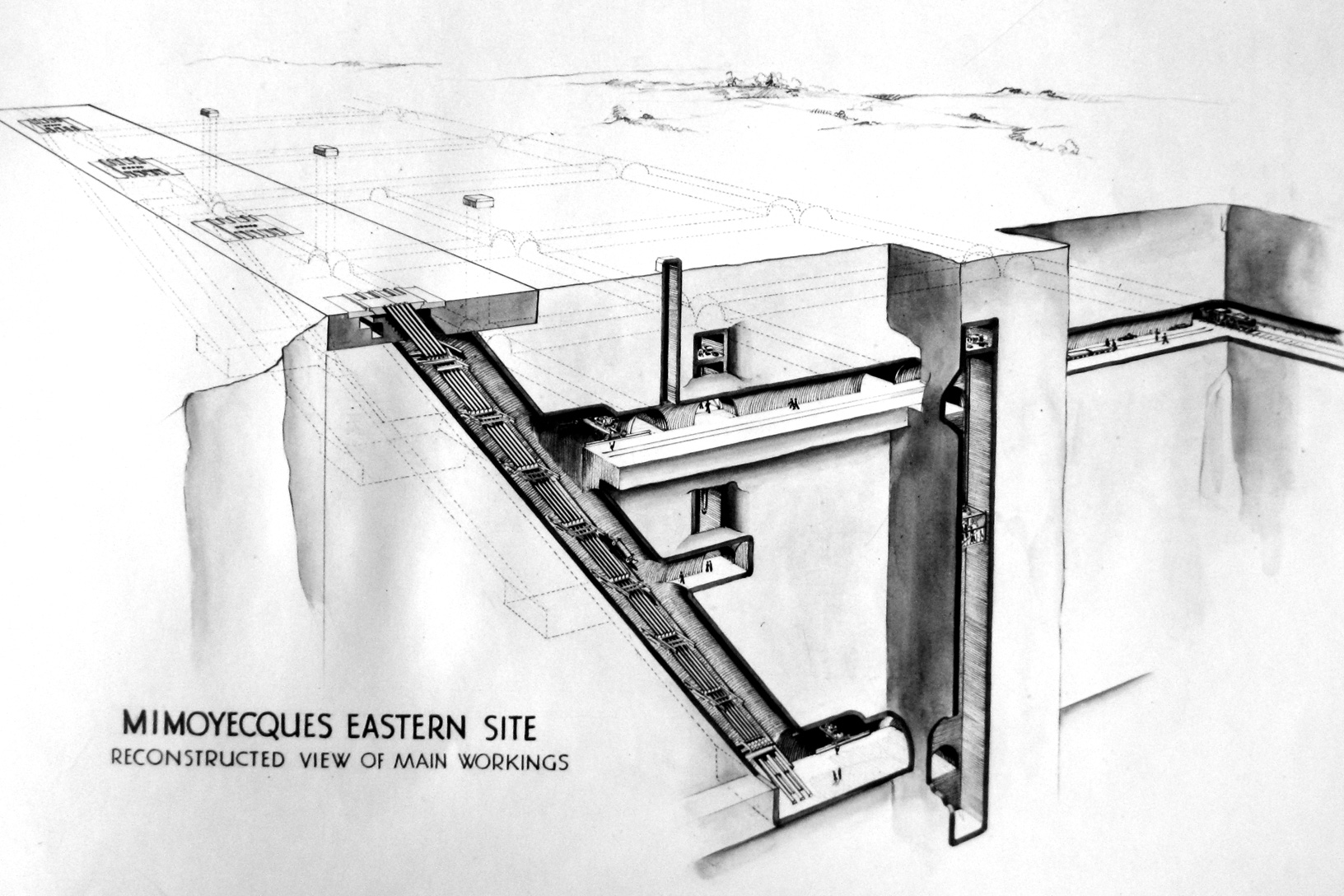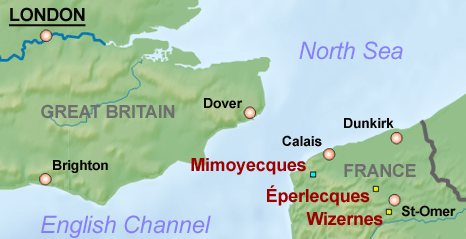|
Bombing Of Mimoyecques During World War II
The Fortress of Mimoyecques () is the modern name for a Second World War underground military complex built by the forces of Nazi Germany between 1943 and 1944. It was intended to house a battery of V-3 cannons aimed at London, away. Originally codenamed ''Wiese'' ("Meadow") or ''Bauvorhaben 711'' ("Construction Project 711"), it is located in the commune of Landrethun-le-Nord in the Pas-de-Calais region of northern France, near the hamlet of Mimoyecques about from Boulogne-sur-Mer. It was constructed by a mostly German workforce recruited from major engineering and mining concerns, augmented by prisoner-of-war slave labour. The complex consists of a network of tunnels dug under a chalk hill, linked to five inclined shafts in which 25 V-3 guns would have been installed, all targeted on London. The guns would have been able to fire ten dart-like explosive projectiles a minute – 600 rounds every hour – into the British capital, which Winston Churchill later commented ... [...More Info...] [...Related Items...] OR: [Wikipedia] [Google] [Baidu] |
Landrethun-le-Nord
Landrethun-le-Nord (; vls, Landerten) is a commune in the Pas-de-Calais department in the Hauts-de-France region of France. Geography A farming village situated some northeast of Boulogne, at the junction of the D243 and D231 roads. History The area was severely bombed during 1944 as the Germans chose this commune to host the V-3 cannon launch site during World War II World War II or the Second World War, often abbreviated as WWII or WW2, was a world war that lasted from 1939 to 1945. It involved the vast majority of the world's countries—including all of the great powers—forming two opposing .... Population Places of interest * The church of St.Martin, dating from the twentieth century. * The Second World War Fortress of Mimoyecques. See also * Communes of the Pas-de-Calais department References Landrethunlenord {{PasdeCalais-geo-stub ... [...More Info...] [...Related Items...] OR: [Wikipedia] [Google] [Baidu] |
Earthquake Bomb
The earthquake bomb, or seismic bomb, was a concept that was invented by the British aeronautical engineer Barnes Wallis early in World War II and subsequently developed and used during the war against strategic targets in Europe. A seismic bomb differs somewhat in concept from traditional bombs, which usually explode at or near the surface, and destroy their target directly by explosive force. In contrast, a seismic bomb is dropped from high altitude to attain very high speed as it falls and upon impact, penetrates and explodes deep underground, causing massive caverns or craters known as ''camouflets'', as well as intense shockwaves. In this way, the seismic bomb can affect targets that are too massive to be affected by a conventional bomb, as well as damage or destroy difficult targets such as bridges and viaducts. Earthquake bombs were used towards the end of World War II on massively reinforced installations, such as submarine pens with concrete walls several meters thick, ... [...More Info...] [...Related Items...] OR: [Wikipedia] [Google] [Baidu] |
August Coenders
August Cönders was a German engineer working for Röchling'sche Eisen und Stahlwerke GmbH during World War II after having worked in the UK and in Putaux, France, before the war. He designed the Röchling shell that was tested in 1942 and 1943 against the Belgian Fort d'Aubin-Neufchâteau and the V-3 cannon The V-3 (german: Vergeltungswaffe 3, ("Vengeance Weapon 3") was a German World War II large-caliber gun working on the multi-charge principle whereby secondary propellant charges are fired to add velocity to a projectile. The Germans pla .... Very little is known of his life after the V-3 project. References External links August Coenders' 9x19mm Belt-Fed MG {{DEFAULTSORT:Conders, August Engineers from Saarland Weapon designers Possibly living people Year of birth missing ... [...More Info...] [...Related Items...] OR: [Wikipedia] [Google] [Baidu] |
Paris Gun
The Paris Gun (german: Paris-Geschütz / Pariser Kanone) was the name given to a type of German long-range siege gun, several of which were used to bombard Paris during World War I. They were in service from March to August 1918. When the guns were first employed, Parisians believed they had been bombed by a high-altitude Zeppelin, as the sound of neither an airplane nor a gun could be heard. They were the largest pieces of artillery used during the war by barrel length, and qualify under the (later) formal definition of large-calibre artillery. Also called the "''Kaiser Wilhelm Geschütz''" (" Kaiser Wilhelm Gun"), they were often confused with Big Bertha, the German howitzer used against Belgian forts in the Battle of Liège in 1914; indeed, the French called them by this name as well.For an instance of war-time naming of this gun as "Big Bertha", see They were also confused with the smaller "Langer Max" (Long Max) cannon, from which they were derived; although the famous Krup ... [...More Info...] [...Related Items...] OR: [Wikipedia] [Google] [Baidu] |
V-weapons
V-weapons, known in original German as (, German: "retaliatory weapons", "reprisal weapons"), were a particular set of long-range artillery weapons designed for strategic bombing during World War II, particularly strategic bombing and/or aerial bombing of cities. They were the V-1, a pulsejet-powered cruise missile; the V-2, a liquid-fueled ballistic missile (often referred to as V1 and V2); and the V-3 cannon. All of these weapons were intended for use in a military campaign against Britain, though only the V-1 and V-2 were so used in a campaign conducted 1944–45. After the invasion of Europe by the Allies, these weapons were also employed against targets on the mainland of Europe, mainly France and Belgium. Strategic bombing with V-weapons killed approximately 18,000 people, mostly civilians. The cities of London, Antwerp and Liège were the main targets. They were part of the range of the so-called (superweapons, or "wonderweapons") of Nazi Germany. Development As e ... [...More Info...] [...Related Items...] OR: [Wikipedia] [Google] [Baidu] |
Large-calibre Artillery
The formal definition of large-calibre artillery used by the United Nations Register of Conventional Arms (UNROCA) is "guns, howitzers, artillery pieces, combining the characteristics of a gun, howitzer, mortar, or multiple-launch rocket system, capable of engaging surface targets by delivering primarily indirect fire, with a calibre of 75 millimetres and above". This definition, shared by the Arms Trade Treaty and the Treaty on Conventional Armed Forces in Europe, is derived from a definition in United Nations General Assembly Resolution 46/36L, which set a threshold of 100mm. Several grammatical changes were made to that latter in 1992 and the threshold was lowered in 2003 to yield the current definition, as endorsed by UN General Assembly Resolution 58/54. Historically, large-calibre weapons have included bombards and siege guns. Late Middle Ages In the context of late medieval siege warfare the term superguns applies to stone-firing bombards with a ball diameter of more ... [...More Info...] [...Related Items...] OR: [Wikipedia] [Google] [Baidu] |
Adolf Hitler
Adolf Hitler (; 20 April 188930 April 1945) was an Austrian-born German politician who was dictator of Nazi Germany, Germany from 1933 until Death of Adolf Hitler, his death in 1945. Adolf Hitler's rise to power, He rose to power as the leader of the Nazi Party, becoming the Chancellor of Germany, chancellor in 1933 and then taking the title of in 1934. During his dictatorship, he initiated European theatre of World War II, World War II in Europe by invasion of Poland, invading Poland on 1 September 1939. He was closely involved in military operations throughout the war and was central to the perpetration of the Holocaust: the genocide of Holocaust victims, about six million Jews and millions of other victims. Hitler was born in Braunau am Inn in Austria-Hungary and was raised near Linz. He lived in Vienna later in the first decade of the 1900s and moved to Germany in 1913. He was decorated during his Military career of Adolf Hitler, service in the German Army in Worl ... [...More Info...] [...Related Items...] OR: [Wikipedia] [Google] [Baidu] |
Albert Speer
Berthold Konrad Hermann Albert Speer (; ; 19 March 1905 – 1 September 1981) was a German architect who served as the Minister of Armaments and War Production in Nazi Germany during most of World War II. A close ally of Adolf Hitler, he was convicted at the Nuremberg trials and sentenced to 20 years in prison. An architect by training, Speer joined the Nazi Party in 1931. His architectural skills made him increasingly prominent within the Party, and he became a member of Hitler's inner circle. Hitler commissioned him to design and construct structures including the Reich Chancellery and the Nazi party rally grounds in Nuremberg. In 1937, Hitler appointed Speer as General Building Inspector for Berlin. In this capacity he was responsible for the Central Department for Resettlement that evicted Jewish tenants from their homes in Berlin. In February 1942, Speer was appointed as Reich Minister of Armaments and War Production. Using misleading statistics, he promoted himsel ... [...More Info...] [...Related Items...] OR: [Wikipedia] [Google] [Baidu] |
Bundesarchiv Bild 146-1981-147-30A, Hochdruckpumpe V-3
The German Federal Archives or Bundesarchiv (BArch) (german: Bundesarchiv) are the National Archives of Germany. They were established at the current location in Koblenz in 1952. They are subordinated to the Federal Commissioner for Culture and the Media ( Claudia Roth since 2021) under the German Chancellery, and before 1998, to the Federal Ministry of the Interior. On 6 December 2008, the Archives donated 100,000 photos to the public, by making them accessible via Wikimedia Commons. History The federal archive for institutions and authorities in Germany, the first precursor to the present-day Federal Archives, was established in Potsdam, Brandenburg in 1919, a later date than in other European countries. This national archive documented German government dating from the founding of the North German Confederation in 1867. It also included material from the older German Confederation and the Imperial Chamber Court. The oldest documents in this collection dated back to the year ... [...More Info...] [...Related Items...] OR: [Wikipedia] [Google] [Baidu] |
Saint-Omer
Saint-Omer (; vls, Sint-Omaars) is a commune and sub-prefecture of the Pas-de-Calais department in France. It is west-northwest of Lille on the railway to Calais, and is located in the Artois province. The town is named after Saint Audomar, who brought Christianity to the area. The canalised section of the river Aa begins at Saint-Omer, reaching the North Sea at Gravelines in northern France. Below its walls, the Aa connects with the Neufossé Canal, which ends at the river Lys. History Saint-Omer first appeared in the writings during the 7th century under the name of Sithiu (Sithieu or Sitdiu), around the Saint-Bertin abbey founded on the initiative of Audomar, (Odemaars or Omer). Omer, bishop of Thérouanne, in the 7th century established the Abbey of Saint Bertin, from which that of Notre-Dame was an offshoot. Rivalry and dissension, which lasted till the French Revolution, soon sprang up between the two monasteries, becoming especially virulent when in 1559 St Omer ... [...More Info...] [...Related Items...] OR: [Wikipedia] [Google] [Baidu] |
La Coupole
''La Coupole'' ( en, The Dome), also known as the ''Coupole d'Helfaut-Wizernes'' and originally codenamed ''Bauvorhaben'' 21 ('Building Project 21') or ''Schotterwerk Nordwest'' (Northwest Gravel Works), is a Second World War bunker complex in the Pas-de-Calais '' department'' of northern France, about from Saint-Omer, and some 14.4 kilometers (8.9 miles) south-southeast from the less developed Blockhaus d'Eperlecques V-2 launch installation in the same area. It was built by the forces of Nazi Germany between 1943 and 1944 to serve as a launch base for V-2 rockets directed against London and southern England, and is the earliest known precursor to modern underground missile silos still in existence. Constructed in the side of a disused chalk quarry, the most prominent feature of the complex is an immense concrete dome, to which its modern name refers. It was built above a network of tunnels housing storage areas, launch facilities and crew quarters. The facility was designed to ... [...More Info...] [...Related Items...] OR: [Wikipedia] [Google] [Baidu] |








